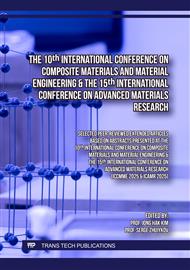[1]
EC–European Commission, 2019. Communication from the Commission to the European Parliament, the European Council, the Council, the European Economic and Social Committee and the Committee of the Regions–The European Green Deal. Document 52019DC0640, 640S.
DOI: 10.54648/eerr1996017
Google Scholar
[2]
Pomponi, F. and Moncaster, A., 2016. Embodied carbon mitigation and reduction in the built environment–What does the evidence say? Journal of environmental management, 181, p.687
DOI: 10.1016/j.jenvman.2016.08.036
Google Scholar
[3]
A review on use of limestone powder in cement-based materials: Mechanism, hydration and microstructures
Google Scholar
[4]
Badalyan, M.M., Muradyan, N.G., Shainova, R.S., Arzumanyan, A.A., Kalantaryan, M.A., Sukiasyan, R.R., Yeranosyan, M., Laroze, D., Vardanyan, Y.V. and Barseghyan, M.G., 2024. Effect of Silica Fume Concentration and Water–Cement Ratio on the Compressive Strength of Cement-Based Mortars. Buildings, 14(3), p.757.
DOI: 10.3390/buildings14030757
Google Scholar
[5]
Benabed, B., Soualhi, H., Belaidi, A.S.E., Azzouz, L. and Kenai, S., 2016. Effect of limestone powder as a partial replacement of crushed quarry sand on properties of self-compacting repair mortars. Journal of Building Materials and Structures, 3(1), pp.15-30.
DOI: 10.34118/jbms.v3i1.21
Google Scholar
[6]
Aldred, J.M., Holland, T.C., Morgan, D.R., Roy, D.M., Bury, M.A., Hooton, R.D., Olek, J., Scali, M.J., Detwiler, R.J. and Jaber, T.M., 2006. Guide for the use of silica fume in concrete. ACI–American Concrete Institute–Committee: Farmington Hills, MI, USA, 234.
Google Scholar
[7]
Uddin, M.A., Bashir, M.T., Khan, A.M., Alsharari, F., Farid, F. and Alrowais, R., 2024. Effect of Silica Fume on Compressive Strength and Water Absorption of the Portland Cement–Silica Fume Blended Mortar. Arabian Journal for Science and Engineering, 49(4), pp.4803-4811.
DOI: 10.1007/s13369-023-08204-x
Google Scholar
[8]
Türkel, S. and Altuntaş, Y., 2009. The effect of limestone powder, fly ash and silica fume on the properties of self-compacting repair mortars. Sadhana, 34, pp.331-343.
DOI: 10.1007/s12046-009-0011-3
Google Scholar
[9]
Benli, A., 2019. Mechanical and durability properties of self‐compacting mortars containing binary and ternary mixes of fly ash and silica fume. Structural Concrete, 20(3), pp.1096-1108.
DOI: 10.1002/suco.201800302
Google Scholar
[10]
A. I. Nicoara et al., "End-of-life materials used as supplementary cementitious materials in the concrete industry," Materials, vol. 13, no. 8, p.1954, (2020)
Google Scholar
[11]
Favier, A., De Wolf, C., Scrivener, K. and Habert, G., 2018. A sustainable future for the European Cement and Concrete Industry: Technology assessment for full decarbonisation of the industry by 2050. ETH Zurich.
Google Scholar
[12]
Nodehi, M. and Taghvaee, V.M., 2022. Applying circular economy to construction industry through use of waste materials: a review of supplementary cementitious materials, plastics, and ceramics. Circular Economy and Sustainability, 2(3), pp.987-1020.
DOI: 10.1007/s43615-022-00149-x
Google Scholar
[13]
CYS EN 1936. "Natural stone test methods. Determination of real density and apparent density, and of total and open porosity". Brussels: CEN, (2006).
DOI: 10.3403/01663707u
Google Scholar
[14]
CYS EN 1925. "Natural stone test methods. Determination of water absorption coefficient by capillarity". Brussels: CEN, (1999)
Google Scholar
[15]
Kanellopoulos, A., Petrou, M.F. and Ioannou, I., 2012. Durability performance of self-compacting concrete. Construction and Building Materials, 37, pp.320-325.
DOI: 10.1016/j.conbuildmat.2012.07.049
Google Scholar
[16]
Adesina, A., 2021. Overview of the influence of waste materials on the thermal conductivity of cementitious composites. Cleaner Engineering and Technology, 2, p.100046.
DOI: 10.1016/j.clet.2021.100046
Google Scholar
[17]
Kyriakidis, A., Michael, A., Illampas, R., Charmpis, D.C. and Ioannou, I., 2019. Comparative evaluation of a novel environmentally responsive modular wall system based on integrated quantitative and qualitative criteria. Energy, 188, p.115966.
DOI: 10.1016/j.energy.2019.115966
Google Scholar



